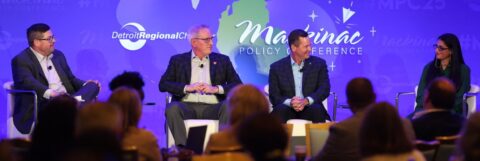- Federal funding for university research is crucial in advancing medical breakthroughs, such as improved survival rates for pancreatic cancer, and addressing public health crises like the Flint Water Crisis.
- Public health initiatives, such as the Flint Registry, face instability due to funding cuts, threatening long-term community health monitoring and the retention of talented researchers.
- Sustained research funding is vital for economic growth and global competitiveness, with examples like Tesla and SpaceX born from federally funded university research.

Top Takeaways
Opening Remarks, Panelists, and Moderator
Higher education research is a critical economic and community development drive that fosters innovation, job creation, and regional growth.
In a conversation with Livengood, Crawford, Elliott, and Hanna explored how university research institutions are essential to the equation of Michigan’s continued growth and how federal funding cuts and policy changes will hinder the development and innovation for key job sectors.
The Impact of Funding Cuts on University Research
The median survival time for pancreatic cancer is 10 months, according to Crawford.
When patients are first diagnosed, they are often told to “get their affairs in order,” a sentiment Crawford strongly opposes. Instead, he believes the first piece of advice should be to seek out a university hospital. “That’s where the second opinions are going to come. That’s where the trials are being conducted. That’s your best hope,” Crawford said.
Statistics corroborate this. Since Crawford began his research 25 years ago, the five-year survival rate for pancreatic cancer has improved significantly, from just 5% to 13%.
One key driver of this progress has been fundamental research, much of which occurs at the university level. Crawford emphasized that this type of research is often not profitable, so it is primarily conducted in academic settings.
Hanna, a pediatrician known for her pivotal research exposing the Flint Water Crisis, echoed this sentiment.
“We are there to work hand-in-hand with communities to promote the common good; to do the difficult work that nobody else wants to do; to do the trusted, credible work; to improve the situation of the populations that we’re privileged to work in,” she said. “That work was based on research. It was science that helped protect the entire community.”
Challenges Facing Public Health Programs
When university research funding is cut, breakthroughs in cancer and disease research are stalled. Due to recent changes in funding and policy, public health programs are also increasingly at risk. One example is the Flint Registry, a vital initiative that monitors the long-term impacts of the Flint Water Crisis, with over 20,000 people voluntarily enrolled.
The registry is funded as a line item in the Centers for Disease Control and Prevention (CDC) budget, receiving $5 million annually. Although it was re-funded in 2025, Hanna shared that its future remains uncertain due to the elimination of the CDC’s Childhood Lead Poisoning Prevention Program.
“We’re in this state of limbo: it might get renewed. It might not get renewed. It could be in next year’s budget. It might not be in next year’s budget,” Hanna said. “… having this uncertainty creates a pause in the work, and we often then lose incredible talent, and it’s hard to move forward.”
The Business Case for Sustained Research Funding
From a business perspective, Elliott highlighted that federally funded research conducted at the university level in the U.S. is often taken for granted, even though it serves as “a key bedrock of our competitiveness.”
He pointed out that the 10 most valuable companies on the New York Stock Exchange today, like Tesla and SpaceX, are all due to technology originally developed at a university or by federally funded investment.
“All of this started with an influx of talent that came from Western Europe at the beginning of WWII. And that is what built up a lot of our research universities in this country,” Elliott said. “That talent is now under threat. It’s mobile.”
By “mobile,” Elliott referred to Hanna’s concerns about the risk of losing talent due to the nation’s growing uncertainty.
The European Union recently approved 500 million euros to recruit researchers, primarily from the U.S., as part of its new “Choose Europe for Science” campaign for 2025-2027. The UK has also approved an initiative with a similar cause.
Additionally, a recent poll by “Nature,” surveying more than 1,200 researchers, revealed that 75% are considering leaving the U.S. to continue their work.
“That continuity of research is really important because a dollar spent at the federal level today shows up in the economy roughly 12 years later,” Elliott said. “So, it’s important that we have this level of continuity and that we continue to fund this research at a high level. We need this to continue to be competitive in the world.”
This 2025 Mackinac Policy Conference session was hosted by Michigan State University.

The Chamber has the most robust education and talent portfolio in the state.
Learn how to get involved with our programs and initiatives.
Contact Us





